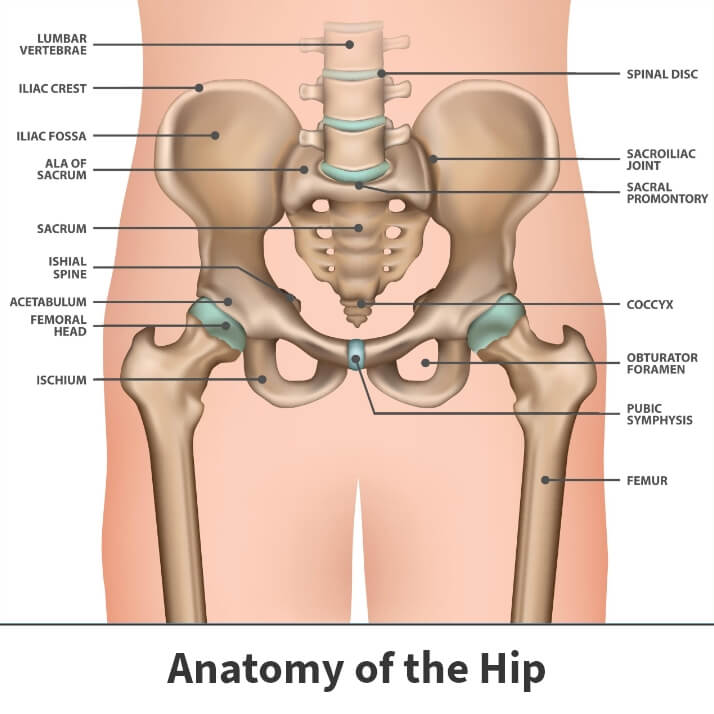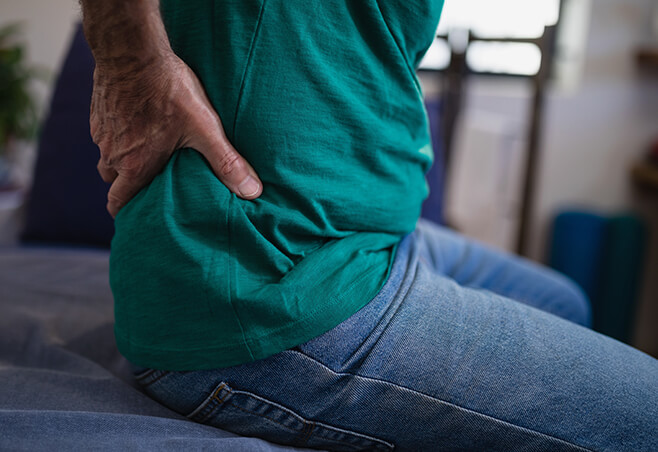Anatomy

The hip is a ball-and-socket joint as well as one of the body’s largest joints. The socket is formed by the acetabulum, which is part of the large pelvis bone. The ball is the femoral head, which is the upper end of the femur (thighbone). The bone surfaces of the ball and socket are covered with articular cartilage, a smooth tissue that cushions the ends of the bones and enables them to move easily.
A thin tissue called synovial membrane surrounds the hip joint. In a healthy hip, this membrane makes a small amount of fluid that lubricates the cartilage and eliminates almost all friction during hip movement. The hip joint also contains bands of tissue called ligaments that connect the ball to the socket and provide stability to the joint.
About
A total hip replacement is a type of surgery that involves replacing your hip joint with an artificial one. Total hip replacement with anterior approach refers to operations done from in front of the hip. These surgeries care also called mini, modified, minimally invasive, or muscle-sparing surgeries.
If your hip has been damaged by arthritis, a fracture, or other conditions, common activities such as walking or getting in and out of a chair may be painful and difficult. Your hip may be stiff, and it may be hard to put on your shoes and socks. You may even feel uncomfortable while resting.
If medications, changes in your everyday activities, the use of walking supports, or other nonsurgical treatments are ineffective, consider hip replacement surgery. Hip replacement surgery is a safe and effective procedure that can relieve your pain, increase motion, and help you get back to enjoying normal activities.

Treatment
The purpose of most hip replacements is to treat pain and damage from arthritis. In osteoarthritis, long-term wear-and-tear damages the joint. In rheumatoid arthritis, inflammation causes pain, swelling, stiffness, and tissue damage. Other reasons for getting a hip replacement include:
- Broken or injured hip
- Bone that has died because it did not get enough blood (avascular necrosis or osteonecrosis)
- Bone tumors
Advantages of anterior hip replacement
Anterior hip replacement surgery offers several advantages, including:
- Less damage to major muscles – There are fewer muscles at the front of the hip, so an anterior approach avoids cutting major muscles. The surgeon works between them, rather than detaching muscles from bones or cutting through muscle fibers.
- Less post-operative pain – By not cutting major muscles, there is less pain after surgery and less need for pain medication.
- Faster recovery – People who have anterior hip replacements stop using walkers, canes, and other assistive devices sooner than traditional hip surgery patients, according to research.
- Fewer post-surgical precautions – These are precautions typically following the first six weeks after surgery to prevent the new hip from dislocating. There are fewer post-surgical precautions with an anterior hip replacement.
There are also some potential limitations and disadvantages of anterior hip replacement including wound healing, certain types of patients, and the skill of the surgeon.
Speak to your Florida Orthopaedic Institute surgeon about the potential advantages and disadvantages based on your specific circumstances, such as the type of your hip arthritis, anatomy, overall health, and lifestyle.
The procedure
During the procedure, you will likely get general anesthesia so that you are not awake during the surgery. The skin around the surgical site is cleaned, and all hair removed. Your surgeon will then make a cut in front of your hip joint and separate your muscles to see your hip joint. Next, your surgeon removes the upper part of your femur and the damaged cartilage and bone from your pelvis. Your surgeon then replaces your acetabulum and the head, neck, and part of the shaft of your femur with an artificial joint. To make sure the joint is in the right place, your surgeon may take an X-ray. Finally, your surgeon or an assistant closes the incision.
Total hip replacement with an anterior approach is not an option for everyone. You may have other surgical choices, such as total hip resurfacing. Talk with your Florida Orthopaedic Institute physician to determine which procedure will work best for you.
Recovery
After your surgery, you will most likely have to go to physical therapy to regain strength and flexibility in the hip. The success of your surgery will depend significantly on how well you follow the recovery steps during the first few weeks after surgery. For example, avoid getting your stitches wet until they have healed, maintaining a balanced diet, and exercising regularly.
Learn More About Physical Therapy
Additionally, your artificial hip may wear out or loosen over time. Eventually, you might need another surgery to replace the parts. You can help extend the life of your implant by exercising regularly and taking precautions to avoid falls.
Videos
Related specialties
- Avascular Necrosis (Osteonecrosis)
- Groin Strains & Pulls
- Hamstring Injuries
- Hip Arthroscopy
- Hip Dislocation
- Hip Flexor Strains
- Hip Fractures
- Hip Hemiarthroplasty
- Hip Impingement Labral Tears
- Hip Muscle Strains
- Hip Pointers & Trochanteric Bursitis
- Iliopsoas Tenotomy
- Labral Tears of the Hip (Acetabular Labrum Tears)
- Osteoarthritis of the Hip
- Osteoporosis
- Pelvic Ring Fractures
- Piriformis Syndrome
- Sports Hernias (Athletic Pubalgia)
- Thigh Fractures
- Thigh Muscle Strains
- Total Hip Arthroplasty
